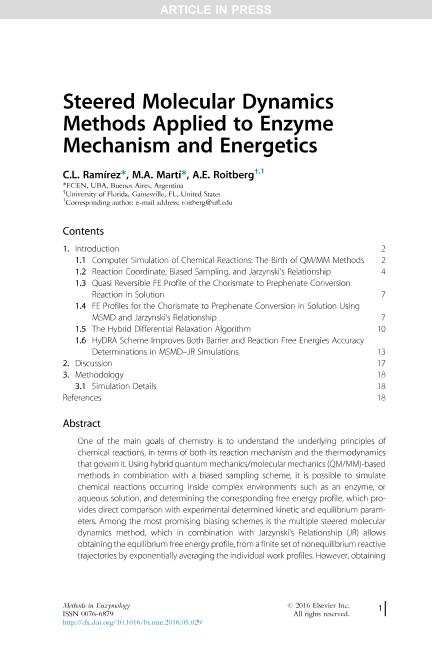Mostrar el registro sencillo del ítem
dc.contributor.author
Ramírez, Claudia Lilián

dc.contributor.author
Marti, Marcelo Adrian

dc.contributor.author
Roitberg, Adrián

dc.date.available
2018-08-15T15:25:37Z
dc.date.issued
2016-01
dc.identifier.citation
Ramírez, Claudia Lilián; Marti, Marcelo Adrian; Roitberg, Adrián; Steered Molecular Dynamics Methods Applied to Enzyme Mechanism and Energetics; Elsevier Academic Press Inc; Methods In Enzymology.; 578; 1-2016; 123-143
dc.identifier.issn
0076-6879
dc.identifier.uri
http://hdl.handle.net/11336/55602
dc.description.abstract
One of the main goals of chemistry is to understand the underlying principles of chemical reactions, in terms of both its reaction mechanism and the thermodynamics that govern it. Using hybrid quantum mechanics/molecular mechanics (QM/MM)-based methods in combination with a biased sampling scheme, it is possible to simulate chemical reactions occurring inside complex environments such as an enzyme, or aqueous solution, and determining the corresponding free energy profile, which provides direct comparison with experimental determined kinetic and equilibrium parameters. Among the most promising biasing schemes is the multiple steered molecular dynamics method, which in combination with Jarzynski's Relationship (JR) allows obtaining the equilibrium free energy profile, from a finite set of nonequilibrium reactive trajectories by exponentially averaging the individual work profiles. However, obtaining statistically converged and accurate profiles is far from easy and may result in increased computational cost if the selected steering speed and number of trajectories are inappropriately chosen. In this small review, using the extensively studied chorismate to prephenate conversion reaction, we first present a systematic study of how key parameters such as pulling speed, number of trajectories, and reaction progress are related to the resulting work distributions and in turn the accuracy of the free energy obtained with JR. Second, and in the context of QM/MM strategies, we introduce the Hybrid Differential Relaxation Algorithm, and show how it allows obtaining more accurate free energy profiles using faster pulling speeds and smaller number of trajectories and thus smaller computational cost.
dc.format
application/pdf
dc.language.iso
eng
dc.publisher
Elsevier Academic Press Inc

dc.rights
info:eu-repo/semantics/openAccess
dc.rights.uri
https://creativecommons.org/licenses/by-nc-sa/2.5/ar/
dc.subject
Free Energy
dc.subject
Jarzynski Relationship
dc.subject
Multiple Time Step
dc.subject
Nonequilibrium Dynamics
dc.subject.classification
Otras Ciencias Químicas

dc.subject.classification
Ciencias Químicas

dc.subject.classification
CIENCIAS NATURALES Y EXACTAS

dc.title
Steered Molecular Dynamics Methods Applied to Enzyme Mechanism and Energetics
dc.type
info:eu-repo/semantics/article
dc.type
info:ar-repo/semantics/artículo
dc.type
info:eu-repo/semantics/publishedVersion
dc.date.updated
2018-08-13T18:30:54Z
dc.journal.volume
578
dc.journal.pagination
123-143
dc.journal.pais
Estados Unidos

dc.journal.ciudad
Burlingto
dc.description.fil
Fil: Ramírez, Claudia Lilián. Consejo Nacional de Investigaciones Científicas y Técnicas; Argentina. Universidad de Buenos Aires. Facultad de Ciencias Exactas y Naturales; Argentina
dc.description.fil
Fil: Marti, Marcelo Adrian. Consejo Nacional de Investigaciones Científicas y Técnicas; Argentina. Universidad de Buenos Aires. Facultad de Ciencias Exactas y Naturales; Argentina
dc.description.fil
Fil: Roitberg, Adrián. University of Florida; Estados Unidos
dc.journal.title
Methods In Enzymology.

dc.relation.alternativeid
info:eu-repo/semantics/altIdentifier/doi/https://dx.doi.org/10.1016/bs.mie.2016.05.029
dc.relation.alternativeid
info:eu-repo/semantics/altIdentifier/url/https://www.sciencedirect.com/science/article/pii/S0076687916300647
Archivos asociados
